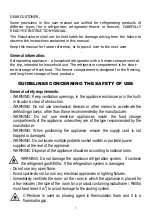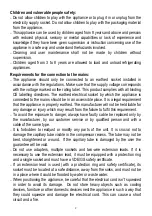
6
TEMPERATURE REGULATION
The temperature in the refrigerator compartment is controlled using the thermostat knob
2
(fig. 1) by turning it to one side or the other. The temperature indication in digits is
shown beside the thermostat knob
2
.
The temperature is regulated on a scale of seven digits.
0
= Compressor is switched off. WARNING! Electric current is not switched off.
1
= highest temperature (lowest cooling)
7
= lowest temperature (highest cooling)
The temperature in the refrigerator compartment can vary due to the ambient
temperature, the amount of food, and the frequent opening of the refrigerator
door.
If the room is cool, the appliance cools less. The temperature in the appliance may
therefore rise. Use the thermostat wheel to set a lower temperature.
FOOD STORAGE
Temperature zones in the refrigerator:
Due to the natural air circulation, there are different temperature zones in the refrigerator
compartment.
1) The upper part of the refrigerator compartment and the door - the warmest area: store
tropical fruits, cans, drinks, eggs, sauces, canned products, butter, jam.
2) The middle part of the refrigerator compartment - cold zone: store cheese, milk, dairy
products, delicacies, yogurt.
3) The lower part of the refrigerator compartment - the coldest area: keep cold snacks,
desserts, meat and fish, cheesecake, fresh pasta, sour cream, pesto / salsa sauce, home-
cooked food, dough, pudding and cream cheese.
4) Fruit and vegetable drawer at the bottom of the refrigerator compartment: Store
vegetables and fruits (except tropical fruits).
To avoid food contamination, follow the instructions below:
• Prolonged opening of the door can significantly increase the temperature in the
compartments of the appliance: only open the door for the time required to place /
remove food.
• Regularly clean surfaces that may come into contact with food and accessible drainage
systems.
• Store fresh meat and fish in suitable containers in the refrigerator so that they do not
come into contact with or drip on other food.
• If the appliance is left empty for a long time, switch it off, defrost, clean, dry and leave
the door open to prevent mold from forming inside the appliance.
Freezing of foodstuff:
Food to be frozen should first be allowed to cool off to room temperature and then should
be placed in one row at the bottom of the freezer compartment.
The thermostat knob should be set to
7
. Fresh foodstuffs prepared for freezing and
cooled to room temperature should be placed in one layer at the bottom of the freezer.
After 24 hours, move the frozen foodstuffs onto the wire shelf
8
(see illustration 1). When
the products are frozen, the thermostat wheel should be
set at its earlier position.






























